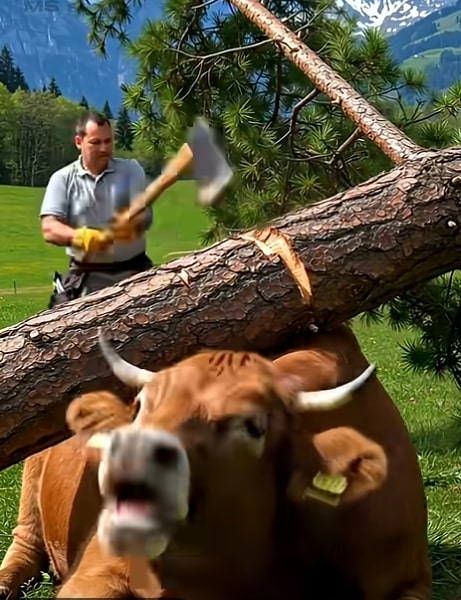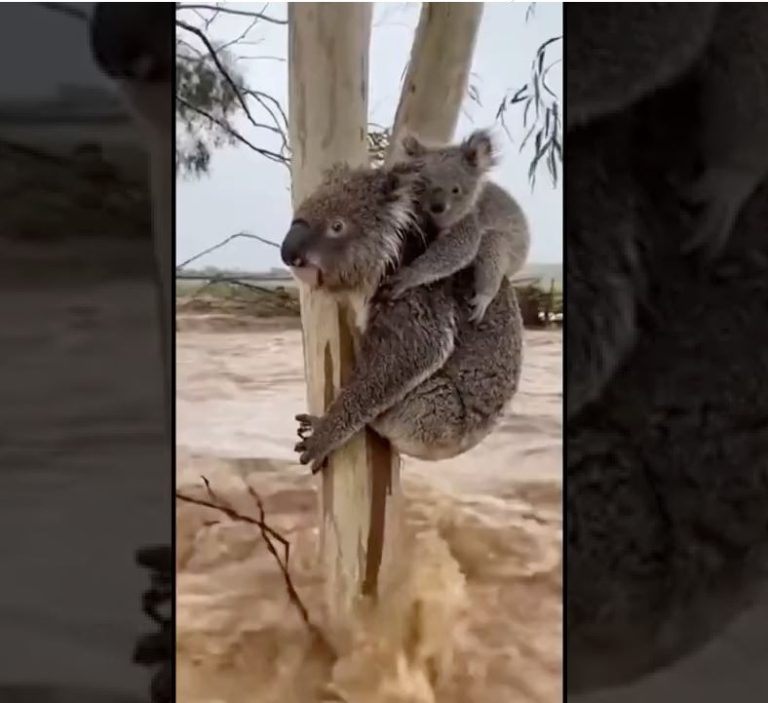When a tree comes down in the countryside, the first thought is usually clearing the path. On this day, the priority was very different: a frightened cow was pinned beneath a heavy trunk, its horns and shoulder wedged by the bark, breathing hard and unable to stand. Within seconds, a local man grabbed an axe, assessed the angle of the trunk, and began cutting—turning a quiet pasture into the scene of a tense, life-or-death rescue.

VIDEO BELOW:
The moment the tree fell
According to witnesses, the pine had likely weakened over time—heavy branches and saturated soil can make even healthy trees unpredictable. The cow, grazing nearby, was caught as the trunk rolled. While the animal was not crushed, the weight prevented it from rising, and its stress escalated quickly.
Staying calm—and making a plan
What makes this rescue remarkable isn’t only the strength required, but the calm planning under pressure. Before the first swing of the axe, the rescuer did three smart things:
-
Checked the cow’s breathing and position. The animal’s chest had room to expand; there was no immediate suffocation risk.
-
Chocked the trunk for stability. Loose branches and wedges help keep a heavy log from rolling while it’s being cut.
-
Chose a safe cut. He started with a shallow notch aimed away from the cow to control how the trunk would split and relieve pressure gradually.
These choices lowered risk to both the animal and the rescuer—a crucial part of any large-animal rescue.
Cutting against the clock
With each strike, wood fibers cracked and tension released. The cow bellowed, a sign of stress but also of relief as weight shifted. The man alternated between chopping a controlled notch and checking that the trunk wasn’t rolling toward the cow’s ribcage. When the main fibers gave way, helpers guided the log outward. The cow slid free, scrambled to its knees, and—after a brief pause—stood up.
Cheers broke out. The cow shook off bark and dirt and walked to the shade, watched closely for signs of limpness or shallow breathing. From panic to relief, the entire scene unfolded in minutes.
Why this rescue worked
-
Rapid assessment. Seconds matter with heavy compression on the chest or abdomen.
-
Control of movement. Wedges, branches, or a pry bar can keep a trunk from shifting the wrong way.
-
Clear escape path. As pressure released, the cow had space to roll and stand without getting re-pinned.
-
Team communication. One person cut; others stabilized and watched the cow’s legs and horns.
Safety tips for similar emergencies (educational content)
Note: Always prioritize professional help when available. If an animal is severely injured or the tree is unstable, call local animal services, a veterinarian, or emergency responders.
-
Keep people back. A freed cow can kick or bolt unexpectedly. Maintain a clear semicircle around the hind legs.
-
Stabilize the load first. Use wedges, rocks, or a jack to prevent sudden rolling. Never cut a loaded trunk without stabilizing it.
-
Cut to relieve pressure, not for speed. A small relief cut in the right spot is safer than a deep, uncontrolled chop.
-
Watch the animal’s breathing. If the chest can’t expand, you need immediate professional help.
-
Protect the head and horns. A blanket or jacket can shield eyes from flying chips; avoid tying near the throat.
-
Aftercare matters. Compression injuries can cause delayed swelling or muscle damage. Walk the animal slowly, provide water, and seek veterinary assessment if there’s limping, labored breathing, or shock.
The bigger picture: compassion on the farm
Rural life often requires fast, practical problem-solving. This video resonated online because it shows quiet heroism: no sirens, no spotlight—just people using the tools at hand to save a life. For many farmers, animals are family and livelihood. Acts like this remind us how closely human care and animal welfare are linked.
What to do if a tree threatens livestock on your land
-
Inspect after storms. Walk fence lines and check older trees with heavy lean or cracked forks.
-
Trim risk branches. Reduce sail weight over grazing areas.
-
Create safe zones. Provide alternate shade structures so animals don’t cluster under suspect trees.
-
Keep basic gear ready. Wedges, a hand saw or axe, a pry bar, halter/lead rope, and a charged phone.
-
Know your pros. Save contacts for a local vet, large-animal rescue group, and a tree service.
Share the good
Positive stories travel far—especially when they offer practical lessons. If you share this rescue, consider adding a note on safe cutting techniques and the importance of veterinary checkups after a compression incident. The more we educate, the more lives we can protect—human and animal.



